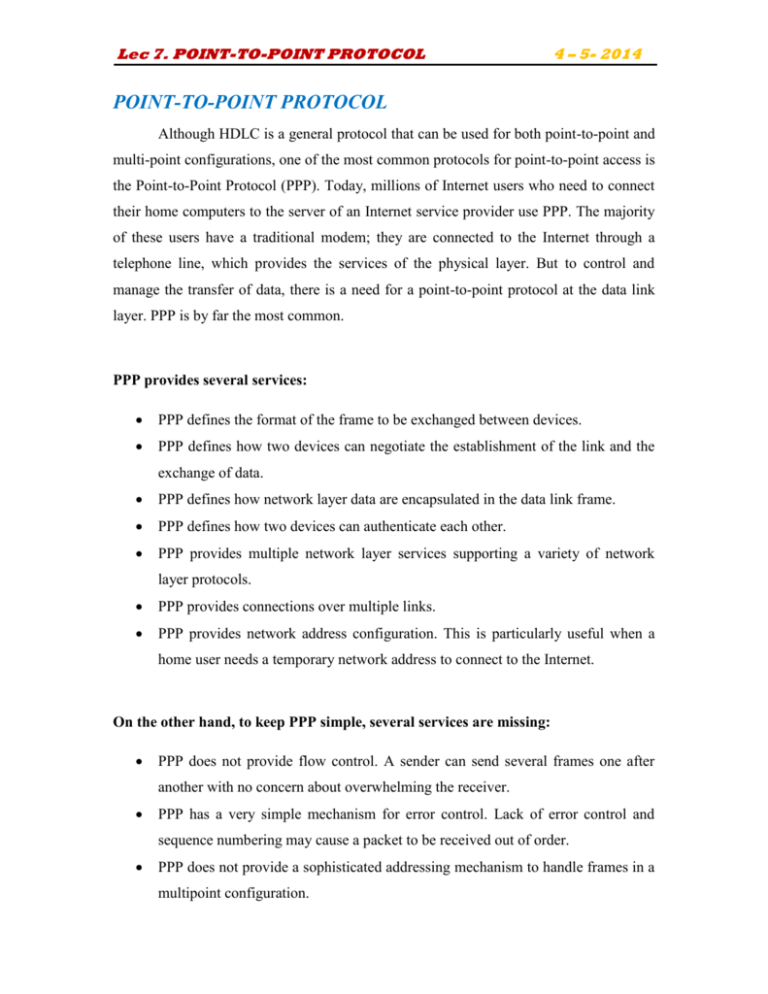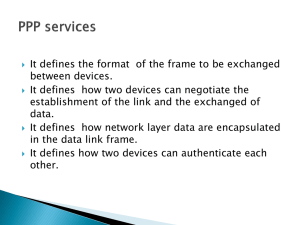Authentication Protocols
advertisement

Lec 7. POINT-TO-POINT PROTOCOL 4 – 5- 2014 POINT-TO-POINT PROTOCOL Although HDLC is a general protocol that can be used for both point-to-point and multi-point configurations, one of the most common protocols for point-to-point access is the Point-to-Point Protocol (PPP). Today, millions of Internet users who need to connect their home computers to the server of an Internet service provider use PPP. The majority of these users have a traditional modem; they are connected to the Internet through a telephone line, which provides the services of the physical layer. But to control and manage the transfer of data, there is a need for a point-to-point protocol at the data link layer. PPP is by far the most common. PPP provides several services: PPP defines the format of the frame to be exchanged between devices. PPP defines how two devices can negotiate the establishment of the link and the exchange of data. PPP defines how network layer data are encapsulated in the data link frame. PPP defines how two devices can authenticate each other. PPP provides multiple network layer services supporting a variety of network layer protocols. PPP provides connections over multiple links. PPP provides network address configuration. This is particularly useful when a home user needs a temporary network address to connect to the Internet. On the other hand, to keep PPP simple, several services are missing: PPP does not provide flow control. A sender can send several frames one after another with no concern about overwhelming the receiver. PPP has a very simple mechanism for error control. Lack of error control and sequence numbering may cause a packet to be received out of order. PPP does not provide a sophisticated addressing mechanism to handle frames in a multipoint configuration. Lec 7. POINT-TO-POINT PROTOCOL 4 – 5- 2014 Framing PPP is a byte-oriented protocol. Framing is done according to the discussion of byteoriented protocols at the beginning of this semester. Frame Format Figure 1 shows the format of a PPP frame. The description of each field follows: Figure 1: PPP frame format Flag: A PPP frame starts and ends with a 1-byte flag with the bit pattern 01111110. Although this pattern is the same as that used in HDLC, there is a big difference. PPP is a byte-oriented protocol; HDLC is a bit-oriented protocol. The flag is treated as a byte, as we will explain later. Address: The address field in this protocol is a constant value and set to 11111111 (broadcast address). During negotiation, the two parties may agree to omit this byte. Control: This field is set to the constant value 11000000 (imitating unnumbered frames in HDLC). As we will discuss later, PPP does not provide any flow control. Error control is also limited to error detection. This means that this field is not needed at all, and again, the two parties can agree, during negotiation, to omit this byte. Protocol: The protocol field defines what is being carried in the data field: either user data or other information. This field is by default 2 bytes long, but the two parties can agree to use only 1 byte. Payload field: This field carries either the user data or other information. The data field is a sequence of bytes with the default of a maximum of 1500 bytes; but Lec 7. POINT-TO-POINT PROTOCOL 4 – 5- 2014 this can be changed during negotiation. The data field is byte-stuffed if the flag byte pattern appears in this field. FCS: The frame check sequence (FCS) is simply a 2-byte or 4-byte. Byte Stuffing The similarity between PPP and HDLC ends at the frame format. PPP, as we discussed before, is a byte-oriented protocol totally different from HDLC. As a byteoriented protocol, the flag in PPP is a byte and needs to be escaped whenever it appears in the data section of the frame. The escape byte is 01111101, which means that every time the flaglike pattern appears in the data, this extra byte is stuffed to tell the receiver that the next byte is not a flag. PPP is a byte-oriented protocol using byte stuffing with the escape byte 01111101. Transition Phases A PPP connection goes through phases which can be shown in a transition phase diagram (see figure 2). Figure 2: Transition phases Dead: In the dead phase the link is not being used. There is no active carrier (at the physical layer) and the line is quiet. Lec 7. POINT-TO-POINT PROTOCOL 4 – 5- 2014 Establish: When one of the nodes starts the communication, the connection goes into this phase. In this phase, options are negotiated between the two parties. If the negotiation is successful, the system goes to the authentication phase (if authentication is required) or directly to the networking phase. The link control protocol packets, that will be discussed shortly, are used for this purpose. Several packets may be exchanged here. Authenticate: The authentication phase is optional; the two nodes may decide, during the establishment phase, not to skip this phase. However, if they decide to proceed with authentication, they send several authentication packets. If the result is successful, the connection goes to the networking phase; otherwise, it goes to the termination phase. Network: In the network phase, negotiation for the network layer protocols takes place. PPP specifies that two nodes establish a network layer agreement before data at the network layer can be exchanged. The reason is that PPP supports multiple protocols at the network layer. If a node is running multiple protocols simultaneously at the network layer, the receiving node needs to know which protocol will receive the data. Open: In the open phase, data transfer takes place. When a connection reaches this phase, the exchange of data packets can be started. The connection remains in this phase until one of the endpoints wants to terminate the connection. Terminate: In the termination phase the connection is terminated. Several packets are exchanged between the two ends for house cleaning and closing the link. Multiplexing Although PPP is a data link layer protocol, PPP uses another set of other protocols to establish the link, authenticate the parties involved, and carry the network layer data. Three sets of protocols are defined to make PPP powerful: the Link Control Protocol (LCP), two Authentication Protocols (APs), and several Network Control Protocols (NCPs). At any moment, a PPP packet can carry data from one of these protocols in its data field. Data may also come from several different network layers. Lec 7. POINT-TO-POINT PROTOCOL 4 – 5- 2014 Link Control Protocol The Link Control Protocol (LCP) is responsible for establishing, maintaining, configuring, and terminating links. It also provides negotiation mechanisms to set options between the two endpoints. Both endpoints of the link must reach an agreement about the options before the link can be established. All LCP packets are carried in the payload field of the PPP frame with the protocol field set to C021 in hexadecimal. There are three categories of packets. The first category is used for link configuration during the establish phase. The second category is used for link termination during the termination phase. The last category is used for link monitoring and debugging. There are many options that can be negotiated between the two endpoints. Options are inserted in the information field of the configuration packets. In this case, the information field is divided into three fields: option type, option length, and option data. Authentication Protocols Authentication plays a very important role in PPP because PPP is designed for use over dial-up links where verification of user identity is necessary. Authentication means validating the identity of a user who needs to access a set of resources. PPP has created two protocols for authentication: Password Authentication Protocol and Challenge Handshake Authentication Protocol. Note that these protocols are used during the authentication phase. PAP The Password Authentication Protocol (PAP) is a simple authentication procedure with a two-step process: 1. The user who wants to access a system sends an authentication identification (usually the user name and a password). Lec 7. POINT-TO-POINT PROTOCOL 4 – 5- 2014 2. The system checks the validity of the identification and password and either accepts or denies connection. There are the three types of packets used by PAP. When a PPP frame is carrying any PAP packets, the value of the protocol field is C023. The three PAP packets are authenticate-request, authenticate-ack, and authenticate-nak. The first packezt is used by the user to send the user name and password. The second is used by the system to allow access. The third is used by the system to deny access. CHAP The Challenge Handshake Authentication Protocol (CHAP) is a three-way handshaking authentication protocol that provides greater security than PAP. In this method, the password is kept secret; it is never sent online. 1. The system sends the user a challenge packet containing a challenge value, usually a few bytes. 2. The user applies a predefined function that takes the challenge value and the user's own password and creates a result. The user sends the result in the response packet to the system. 3. The system does the same. It applies the same function to the password of the user (known to the system) and the challenge value to create a result. If the result created is the same as the result sent in the response packet, access is granted; otherwise, it is denied. CHAP is more secure than PAP, especially if the system continuously changes the challenge value. Even if the intruder learns the challenge value and the result, the password is still secret. CHAP packets are encapsulated in the PPP frame with the protocol value C223 in hexadecimal. There are four CHAP packets: challenge, response, success, and failure. The first packet is used by the system to send the challenge value. The second is used by the user to return the result of the calculation. The third is used by the system to allow access to the system. The fourth is used by the system to deny access to the system.







